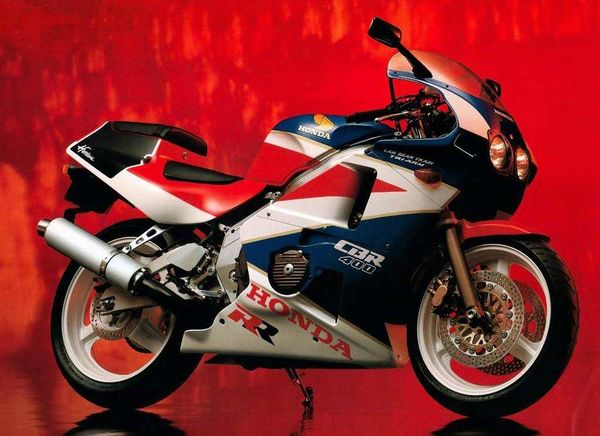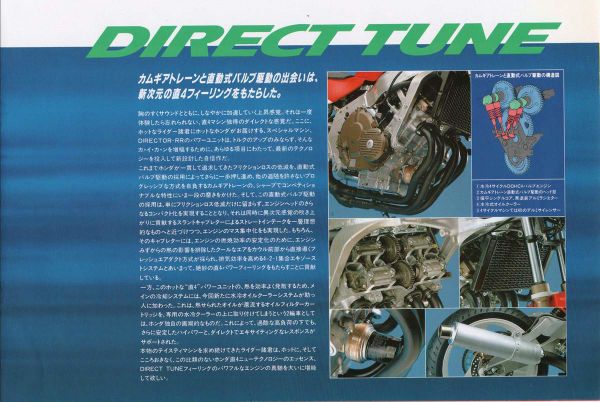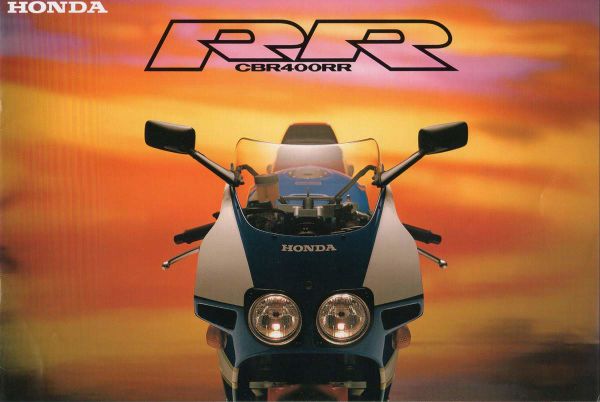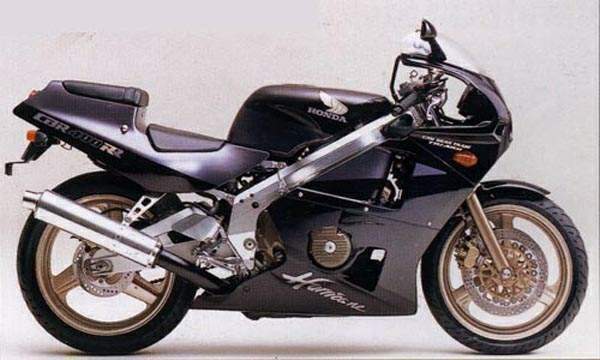Honda CBR400RR
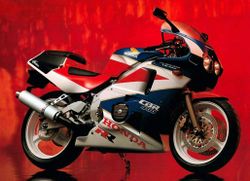 |
|
| Honda CBR400 Fireblade | |
| Manufacturer | |
|---|---|
| Also called | CBR400RR Fireblade, CBR 400 RR Fireblade, CBR 400F, CBR400R, CBR400RR, CBR400F |
| Production | 1987 |
| Class | Sportbike |
| Engine | Four stroke, transverse four cylinder, DOHC, 4 valve per cylinder. |
| Compression ratio | 11.3:1 |
| Ignition | Digitalized full transistor ignition |
| Spark Plug | NGK CR9EH-9 or ND U27FER-9 |
| Battery | 12v (6AH) YTX7A-BS |
| Transmission | 6 Speed |
| Frame | Twin-spar, box-section aluminum |
| Suspension | Front: 41mm Showa damper-rod forks with adjustable pre-load Rear: Showa gas/oil shock with adjustable preload and compression |
| Brakes | Front: 2x 275mm discs 4 piston calipers Rear: Single 220mm disc 2 piston caliper |
| Front Tire | 120/60-17 |
| Rear Tire | 150/60-18 |
| Wheelbase | 1375mm / 54.1 in |
| Seat Height | 750 mm / 29.5 in |
| Weight | 163 kg / 359.4 lbs (dry), |
| Oil Capacity | 3.8 Liters |
| Recommended Oil | Honda GN4 10W-40 |
| Fuel Capacity | 15 Liters / 4.0 gal |
| Manuals | Service Manual |
Engine[edit | edit source]
The engine was a Liquid cooled; radiator with cooling fan cooled Four stroke, transverse four cylinder, DOHC, 4 valve per cylinder.. The engine featured a 11.3:1 compression ratio.
Drive[edit | edit source]
Power was moderated via the Multi-plate, wet.
Chassis[edit | edit source]
It came with a 120/60-17 front tire and a 150/60-18 rear tire. Stopping was achieved via 2x 275mm discs 4 piston calipers in the front and a Single 220mm disc 2 piston caliper in the rear. The front suspension was a 41mm Showa damper-rod forks with adjustable pre-load while the rear was equipped with a Showa gas/oil shock with adjustable preload and compression. The CBR400RR was fitted with a 15 Liters / 4.0 gal fuel tank. The bike weighed just 163 kg / 359.4 lbs. The wheelbase was 1375mm / 54.1 in long.
Photos[edit | edit source]
Overview[edit | edit source]
Honda CBR 400RR
VFR vs CBR
Oh, this copper was
a clever one, all right. He'd already noticed -and noted - the absence of a tax
disc on the Honda CBR I'd been riding until rudely interrupted by the blue
flashing lights of his patrol car. Now he was going to show off his knowledge.
"That's one of those ROOs, isn't it?" he snorted in the
direction of the other Honda, nostrils still flared in anger at the hanging-off
antics I'd been performing for the benefit of Goldman's lens. "I nicked
soinbody on one of them a few weeks ago." (Tim, son of Thompson, as it turned
out).
He was wrong about the bike, although the mistake was
excusable enough. Despite the distictive white-spoked rear wheel hanging from
its single-sided swing arm, the machine the traffic cop was advancing towards
with notebook poised was no VFR750R. And his questions had already established
that the red, white and blue CBR I was riding was not the 600cc steed he'd
naturally assumed it to be, either.
Both machines were 400s and rarer by far, at least in this country, than any RC30 -they're not normally sold in Britain
but were imported by south Loudon dealers Bat Motorcycles direct from Japan,
where the 400cc class is big business. It almost certainly will be here, too, by
1992; if the EEC transport committee has its way, by then all European Community
motorcyclists will be restricted to 400cc bikes for two years after passing
their tests.
Limits of any kind are a pain, but being forced to ride one of
these little beauties would be a lot better than having a hair lining put in
your leathers. The CBR400R -powered, like the 600, by a watercooled, 16-valve
inline four - hides an alloy frame beneath its familiar bulges but from the
outside looks virtually identical to the steel-chassi'ed 600. The
VFR400R-predictably enough a watercooled, 16-valve 90 degree V4 - displays an aluminum
trellis of its own, albeit a slender one resembling that of the VFR750 much more
than the RC's stout skeleton. And if it doesn't quite have all the RC30's
racer-inspired detail touches, either, then it certainly has quite a few.
Both the 400s are equipped with unlinked air forks (with no
damping adjustment), four-pot Nissin front brake calipers with TRAC anti-dive
and discs drilled like a string vest, a single rear shock unit, a full fairing
hiding a big radiator and a tiny oil cooler, and a tacho whose 14-grand redline
invites a serious spanking. There the visual similarities end.
The CBR, like its jelly mould replica siblings, has a tiny
screen, adjustable hand levers, a proper dual seat and three-spoke wheels. The
front, like the 600V is a 17-incher; the rear grows to 18 inches in diameter,
bolts to a box-section alloy swinger and hides behind the familiar swingarm
mounted mudguard. Our bike, a 6400-mile model Bat's had on offer at £2599,
wore a mix of Dunlop front/Pirelli Phantom rear tires, with a further lump of
ugly rubber protecting the rear of the petrol tank, ft was also fitted with a
Japanese four-into-one pipe that I'm sure sounded a whole lot more fuity than
the original blandola four-into-two, but which bore a few scars from a trip down
the road.
The VFR, on the other hand, has no adjustable levers but plenty of pose
power. Essential plastic air ducts run fron the fairing to disappear under the
petrol tank. A much taller screen than the CBR's houses the remote brake
reservoir and the easily-removed speedometer/ warning light assemblies without
which no racerep motorcycle can be taken seriously. And the VFR's rear subframe
is trendy endurance-style bolt-on job - even if it is made of antiquated steel.
Unlike the RC30, the bike does have at least token pillion accommodation: a bit
of foam tacked to the seat hump, plus passenger footrests that necessitate a
mass of gash-looking bracketry to circumnavigate the high-level bulk of the
silencer.
The bike's hefty Pro Arm casting looks roughly similar to the RC30's single-sider,
although the eight-spoke rear wheel is held on by four small nuts instead of one
biggun' -so much for quick release. At 17 inches diameter, the wheel is an inch
smaller than the RC's equivalent, as is the 16-inch front. The shock is
relatively basic, with no adjusters to fiddle with save a handy hydraulic
preload knob down by the rider's left boot.
The bike's two motors, although totally different in the layout of their
cylinders, have many similarities - not least that they share bore and stroke
dimensions of 55 x 42mm and use gears to drive double overhead cams. That might
be expected of the V4, which, like the gear-driven VFR750F motor (but unlike the
RC30) runs a 180-degree crank. But it sets the CBR400 mill apart from Honda's
other inline engines and is noteworthy enough -especially for the gimmick-crazed
Japanese home market - to warrant a "Cam Gear Train" sticker as well as one
bragging of "Advanced Aero Dynamic Force" on the fairing.
The other big similarity is the engines' power outputs, and it's no
coincidence that the claimed max figure for both bikes is 59PS. The Japanese
manufacturers have a gentleman's agreement not to wring more than that many
horses out of a 400cc bike, Bat's boss-man Roger Campbell explained, and the
journalists in Japan are in on the act too. "If Honda quote 59PS as the output,
then 59PS gets published in Japanese magazines," he said.
The limit has provoked Jap aftermarket goodie companies to come up with
tuning kits galore, comprising mufflers, jets and sometimes cams and pistons
too. Bat Motorcycles, realising that the near-five-grand prices they will be
forced to charge for new versions of such small-numbers imports will seem steep
when a stock CBR600 sells for £4000, are planning to fit kits to the 400s they
bring in. "The tuning kits should give another lObhp or so but until we get some
I wouldn't like to say for sure," said Campbell.
These secondhand models -the VFR had 7000 miles up and was on sale at £3499
-remained just as Hammamatsu intended, unless you count the possible assistance
rendered by the CBR's unpronounceably-named exhaust. And the equality didn't
stop at the top-end. After slipping through the south London snarl-ups from
Bat's, photographer DG and I hit the open road. But even after hopping back and
forward between one bike and the other I found myself unable to distinguish
between the two engines' power production right through the rev-range.
The magic number with both is eight grand. Below that figure the motors are as enthusiastic as a
Brosette at a Bach concert, but above it the little bikes take off like a pair
of tube-station pickpockets up the escalator and don't run out of breath till
they've crested the 12,500 rpm pony peak. Crack either throttle open at low revs
and you'd swear the CV carbs were connected by a piece of liquorice. Crouch down
and give either the whizz at 9000rpm plus, though, and you soon start to hope
the police have got some proper criminals to chase.
The revs rise rapidly until before long the speedo needle's threatening to
get too keen for its 18()kph (112mph) top notch. Japanese mags have trapped the
basically similar twin-headlamp 'RR' version of the CBR400 at 138mph, which is a
mere O.Olkph slower than Yamaha's FZR400, the leading straight four, managed.
And although those speeds seem a shade dubious bearing in mind Bike
managed 130mph dead after half a mile on the CBR600, it's obvious that these
little bikes really do shift.
Similar power characteristics shouldn't be taken to imply that the VFR an
CBR400 engines feel identical, because they don't. The CBR mill, predictably, has the familiar slight buzz of a well-balanced straight four while the VFR
has the sweet and Wogan-smooth feel of a typical Honda V4. Its motor reminded me
instantly of the trusty VF500 I'd fronted up at Bat's on, which can only be a
good thing.
The bikes as a whole are even more different to ride. The VFR is small,
firmly spring, racer-like. It's nothing like the RC30 it resembles -lacking that
bike's uniquely tall first gear, its distinctive exhaust drone, its
ultrasensitive steering - but it feels taut and nimble and quick to change line
at the slightest command.
The VFR whipped into corners and floated out of them effortlessly, the smoothness of its engine
initially tricking me into thinking there was some low-down power because it was
often spinning at 9000rpm when I'd imagined the revs to be down below four.
Suspenders at both ends were great, the forks just shaking momentarily when I
hit a drain cover while cranked over on the brakes - which were superb. A touch of the lever pulled the little bike up sharply; a stronger
squeeze almost sent me into handstand mode over the bars.
By comparison, riding the CBR at first felt like walking on stilts. The seat
and handlebars are much higher, and the low, typically useless CBR screen just
added to the impression of sitting on the bike rather than in it as the VFR
pilot does. The handlebars ar more of a stretch, the footpegs lower. The whole
bike has a much more roomy feel although its wheelbase, at 1480mm, is only 5mm
longer that the VFR's and fully 30mm shorter than that of the identical-looking
CBR600.
The CBR's steering wasn't as quick and precise as the V4's but the bigger
bike still handled well, despite a rear shock that had seen better days and was
soggy even when cranked up to max preload. At 3631b dry the CBR is only a couple
of pounds heavier but by comparison it felt a little loose and disjointed. And
its brakes, although they looked identical and worked well enough, didn't have
the teeth of the VFR's.
Aiming the CBR past a lingering puddle on the road, over a patch of new
tarmac and then cranking it repeatedly into a tight roundabout on the photo
session took more thought and effort than the same manoeuvre had earlier aboard
the VFR. The inline motor's buzzier feel at high revs - and the refreshing howl
from its pipe - meant I took the bend a gear higher than I had on the smoother V4. But the Hondas were matched in that both sets of tires stuck to
the road like a politician to an excuse, and both sets of footpegs barely
touched tar as I ripped round with enough speed to make me feel dizzy.
They could both use some more midrange poke, these 400s, but they're handy
little bikes that I for one wouldn't mind riding round on for a couple of
years after graduating from a 125. The law, unfortunately, might well be less
generous. Rather than being allowed tuning kits, it's possible that in 1992
newly-qualified riders will be stuck with a 47bhp (35kW) limit on their 400s.
That would rob this pair of a good chunk of their power and half their fun, and
would be a tragedy even though it might result in their engines being returned
to give a bit more grunt.
The Japanese, meanwhile, are predictably far more concerned with building
faster, lighter, smaller and ever more complex machines within their own
self-imposed 59bhp limit - and with selling the race kits to make them go as
well as they handle and look. Pick of the '89 bunch is the NC30, a real
mini-RC30 with twin headlamps, a 360-degree crank in a more compact V4 motor
than the VFR400R's, RC-type brakes and a beam frame whose wheelbase is 30mm
shorter even than the VFR's.
The NC30's race kit is rumoured to take its power to a barely credible 74bhp,
and the good news is that Bat's man in Japan can get his hands on this bike, too
- though the NC will cost £5250 and you'll have to stump up in advance. Five
grand is a lot of money for a restricted 400, it's true. But for the only
mini-RC30 in the country? Sounds like a bargain to me.
Source Bike Magazine 1988
| Make Model | Honda CBR 400RR |
|---|---|
| Year | 1987 |
| Engine Type | Four stroke, transverse four cylinder, DOHC, 4 valve per cylinder. |
| Displacement | 399 cc / 24.3 cu-in |
| Valve | Intake valve closes @ 1mm lift / Exhaust valve opens @ 1mm lift |
| Bore X Stroke | 55 x 42 mm |
| Cooling System | Liquid cooled; radiator with cooling fan |
| Compression | 11.3:1 |
| Lubrication | Forced pressure and wet sump |
| Oil Pump Type | Trockoid |
| Oil Capacity | 3.8 Liters |
| Induction | 4x 26mm Flat-side CV |
| Charging | Triple phase output alternator |
| Ignition | Digitalized full transistor ignition |
| Spark Plug | NGK CR9EH-9 or ND U27FER-9 |
| Battery | 12v (6AH) YTX7A-BS |
| Starting | Electric |
| Max Power | 59 hp / 42.2 kW @ 12500 rpm |
| Max Torque | 39 Nm / 28.8 ft-lb @ 10000 rpm |
| Clutch | Multi-plate, wet |
| Transmission | 6 Speed |
| Final Drive | Chain |
| Primary Drive | 2.117 |
| Gear Ratio | 1st 3.307 : 1 (43/13) 2nd 2.352 : 1 (40/17) 3rd 1.875 (30/16) 4th 1.591 (35/22)3 5th 1.435 (33/23) 6th 1.318 (29/22) |
| Frame | Twin-spar, box-section aluminum |
| Front Suspension | 41mm Showa damper-rod forks with adjustable pre-load |
| Rear Suspension | Showa gas/oil shock with adjustable preload and compression |
| Front Brakes | 2x 275mm discs 4 piston calipers |
| Rear Brakes | Single 220mm disc 2 piston caliper |
| Font Wheel | 17x3.5 in. |
| Rear Wheel | 17x4.5 in. |
| Front Tire | 120/60-17 |
| Rear Tire | 150/60-18 |
| Rake | 24.3° |
| Trail | 91 mm / 3.6 in |
| Dimensions | Length 1990mm / 78.3 in width 670mm / 26.4 in Height 1080 mm / 42.5 in |
| Wheelbase | 1375mm / 54.1 in |
| Seat Height | 750 mm / 29.5 in |
| Dry Weight | 163 kg / 359.4 lbs |
| Ground Clearance | 125 mm / 4.9 in |
| Fuel Capacity | 15 Liters / 4.0 gal |
